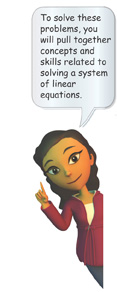3 Pull It All Together

BIG idea Function
The solution of a system of two linear equations corresponds in general to the intersection of the graphs of the corresponding functions.
Task 1
You are given a linear system of two equations in two unknowns. Before solving, describe how you can mentally check whether the system is independent and consistent. In which order would you do your check? Why?
BIG idea Equivalence
You can solve a system of equations by representing the system in some form that is equivalent to the original form but easier to solve. There are different ways to do this.
Task 2
During a back-to-school shopping trip, a group of friends spent $245.86 on 14 shirts and pants. Each shirt cost $11.99. Each pair of pants cost $24.99. How many shirts and pairs of pants did the group buy?
- Write a system of equations to model the information in the problem.
- Study the system. Explain, without solving, which method you think would be most efficient for solving the system: substitution, elimination, graphing, or making a table. Explain why the other methods would be less efficient.
- How could you simplify the numbers used in this system to simplify the system? Does this new system change your answers to part (b)? Explain.
BIG idea Solving Equations and Inequalities
You can represent a system of equations with a matrix. Transforming the matrix to reduced row echelon form gives you an equivalent system for which the solution is obvious.
Task 3
Solve this system using a matrix.
Make three columns on your paper. In the first column, show each step, changing one matrix row at a time. In the second column, write the two equations that correspond to each matrix in the first column. In the third column, describe how you could transform each set of equations to the next.
Table of Contents
- 5-1 Polynomial Functions
- 5-2 Polynomials, Linear Factors, and Zeros
- 5-3 Solving Polynomial Equations
- 5-4 Dividing Polynomials
- 5-5 Theorems About Roots of Polynomial Equations
- 5-6 The Fundamental Theorem of Algebra
- 5-7 The Binomial Theorem
- 5-8 Polynomial Models in the Real World
- 5-9 Transforming Polynomial Functions




